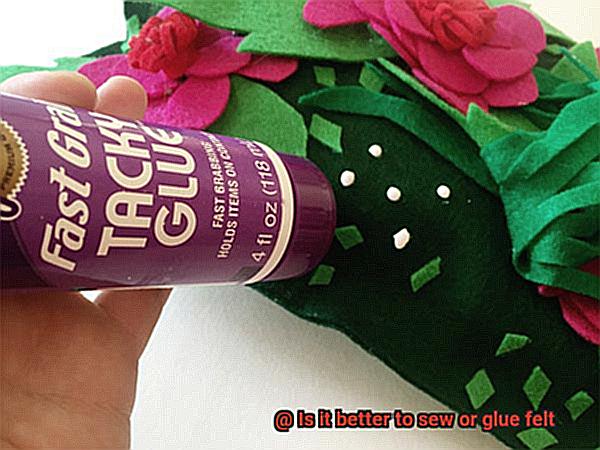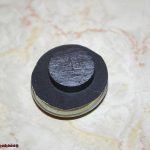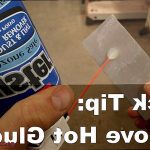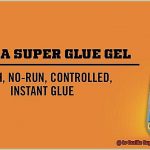Welcome to the mesmerizing world of crafting, where felt holds court as the ultimate material for countless projects. But when it comes to securing this versatile fabric, should you stick with traditional sewing techniques or venture into the realm of gluing? Get ready, because we’re about to embark on a thrilling journey to answer the burning question: is it better to sew or glue felt?
Are you a seasoned seamstress, weaving magic with your needle and thread? Or do you find yourself drawn to the convenience of glue, fascinated by its instant bonding powers? No matter your crafting background, this age-old debate has captivated creators around the globe.
In this captivating exploration, we’ll dive deep into the pros and cons of both techniques, dissecting their advantages and potential pitfalls at every turn.
Sewing, an ancient art form, offers precise control and durability. Delicate stitches intertwine, creating a sturdy bond while preserving the fabric’s integrity. But what about the allure of gluing? No need for threads or needles – just a quick application of adhesive and voila. Your felt masterpiece is complete in a flash.
As we uncover the secrets of sewing, we’ll explore its versatility, varied stitch options, and long-lasting results. Meanwhile, glue enthusiasts will unravel the world of convenience and immediate gratification, balancing adhesive strength with considerations for wear and tear over time.
So whether you’re a crafting connoisseur or an eager beginner, don’t miss out on this epic showdown. Join us as we determine whether sewing or gluing felt takes home the crown. We’ll reveal the keys to crafting success and help you make the perfect choice for your next imaginative endeavor.
Advantages and Disadvantages of Sewing Felt
Contents
- 1 Advantages and Disadvantages of Sewing Felt
- 2 Advantages and Disadvantages of Gluing Felt
- 3 Factors to Consider When Deciding Between Sewing or Gluing Felt
- 4 Sewing vs Gluing for Different Projects
- 5 Combining Sewing and Glue for Enhanced Results
- 6 Tips for Working with Felt
- 7 Common Mistakes When Working with Felt
- 8 Conclusion
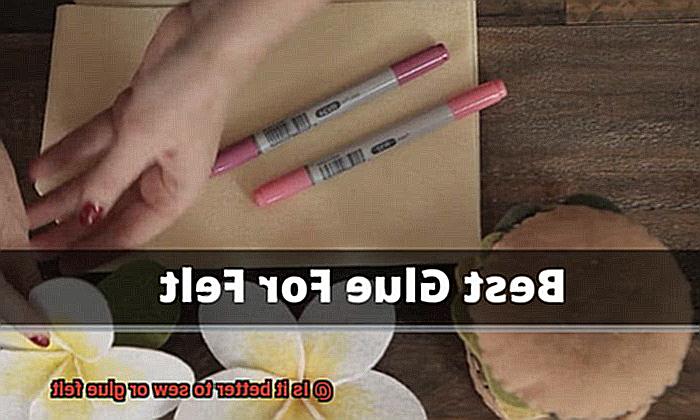
When it comes to affixing felt to different surfaces, sewing and gluing are the top contenders. While both techniques have their merits and drawbacks, sewing offers a secure and long-lasting bond that can withstand wear and tear. In this article, we will delve into the advantages and disadvantages of sewing felt, shedding light on why it has become a go-to method for creating durable, versatile, and customizable felt projects.
Advantages of Sewing Felt:
- Durability: Sewing felt creates a robust connection between the fabric and stitches, ensuring longevity even in the face of regular use. From clothing to accessories and home decor items, sewing felt guarantees durability that can weather the test of time, making it perfect for items that need to withstand the hustle and bustle of everyday life.
- Versatility: Sewing empowers you with unparalleled design flexibility when working with felt. It allows you to weave intricate patterns, incorporate embellishments, and employ various stitching techniques to elevate the overall aesthetic appeal of your project. The versatility offered by sewing opens up a world of limitless creative possibilities.
- Easy Repairs: The beauty of sewing felt lies in its ease of repair. If any part of a sewn felt item becomes damaged or starts unraveling, mending it is relatively straightforward – all you need to do is reinforce the stitches or replace the affected section. This advantage ensures that your beloved felt creations can be repaired effortlessly, maintaining their integrity for years to come.
- Customizability: Sewing grants you the freedom to customize your felt projects according to your preferences. During the sewing process, you can easily alter the shape, size, and design elements, allowing for greater creativity and personalization. This level of customizability ensures that your felt creations truly reflect your unique style and vision.
Disadvantages of Sewing Felt:
Time-consuming: Sewing felt can be a time-consuming process, especially when working on complex designs or larger projects. Each stitch demands meticulous attention to detail, requiring patience and precision. However, the end result justifies the extra effort, as the intricacy and beauty of a sewn felt project are unparalleled.
Advantages and Disadvantages of Gluing Felt
Felt is a versatile and beloved material in the crafting world, but when it comes to joining felt pieces together, the decision between gluing and sewing can be a tough one. As an expert on the subject, I am here to unravel the advantages and disadvantages of gluing felt. So grab your glue gun, because we are about to embark on a journey through the sticky world of felt crafting.
Advantages of Gluing Felt:
Ease and Convenience:
Gluing felt is a quick and effortless method, perfect for those lacking sewing skills. With just a few basic crafting tools, anyone can experience the joy of gluing felt. It’s an ideal choice for speedy projects or when time is of the essence.
Time-Saving Magic:
Wave goodbye to tedious threading and stitching. Gluing felt allows you to swiftly attach pieces together, saving you precious time. No need to fret over perfecting your stitches; simply apply the adhesive, bond the pieces, and witness the magic unfold.
Neat and Seamless Finish:
When executed flawlessly, gluing provides a clean and flawless finish. The adhesive creates a robust bond between the felt pieces, ensuring they stay in place without fraying or unraveling. Prepare to leave your friends in awe with your impeccable crafting skills.
Unleash Your Creative Spirit:
Gluing opens up a world of design possibilities and customization options. Unlike sewing, which imposes limitations on your creativity, gluing allows you to easily attach various embellishments or decorations to your felt projects. It’s time to let your imagination run wild.
Disadvantages of Gluing Felt:
Durability Concerns:
Although gluing may create an initial strong bond, its long-term durability can be questionable. Frequent use or exposure to moisture may weaken or break down the adhesive, causing the felt pieces to separate. If durability is crucial for your project, sewing might be the wiser choice.
Limited Flexibility:
Once felt pieces are glued together, making adjustments or alterations becomes a challenging task without damaging the fabric. Unlike sewing, where stitches can be undone and designs modified easily, gluing offers less room for errors or changes.
Factors to Consider When Deciding Between Sewing or Gluing Felt
When it comes to working with felt, the decision between sewing or gluing can greatly impact the outcome of your project. Each method has its own advantages and drawbacks, making it crucial to consider various factors before making a choice. In this article, we will explore these factors in detail, helping you make an informed decision. Let’s delve into the world of felt crafting.
Durability:
If durability is a top priority, sewing is the superior choice. The tight bond created by sewing ensures that your felt creation will withstand frequent use and handling. On the other hand, glue may not provide the same level of strength and can weaken over time, especially with heavy use.
Flexibility:
Consider the desired flexibility of your felt project. If you need your creation to be flexible and have some stretch, sewing is the way to go. Sewing allows for movement without compromising the integrity of the material. On the contrary, glue can harden and restrict the flexibility of the felt.
Time and Convenience:
Time is often a crucial factor in any crafting project. If you’re short on time or prefer a more convenient approach, gluing is a great option. It saves valuable time compared to sewing, especially for large projects or intricate designs. Therefore, if you have a time-sensitive project or simply prefer a hassle-free experience, gluing may be the best choice.
Aesthetics:
The appearance of your finished project plays a significant role in its overall appeal. Sewing offers a neat and professional look with visible stitches that add to the design aesthetic. This is particularly desirable for applications such as clothing or accessories where stitching becomes part of the visual appeal. Conversely, gluing offers a seamless finish with no visible stitches, making it ideal for crafts or decorative items.
Skill Level:
Consider your skill level when deciding between sewing or gluing felt. Sewing requires some level of expertise with a sewing machine or needle and thread. If you’re new to sewing or lack access to sewing equipment, gluing might be the more beginner-friendly option. The simplicity of glue application eliminates the need for special tools or techniques, making it more accessible for beginners.
Sewing vs Gluing for Different Projects
Today, we’re diving deep into the world of felt crafting and exploring the eternal debate of sewing vs gluing. It’s like choosing between a trusty sidekick and a quick, flashy accomplice – both have their merits, but which one will reign supreme for your project? Fear not, fellow crafters, because I’m here to guide you through the factors to consider when deciding between sewing and gluing for different projects. So grab your favorite cup of tea and let’s get started.
Factor #1: Intended Use
First things first, think about how your project will be used. If it’s something that will be handled or used frequently – like a bag or a garment – sewing is the way to go. Its durability and strength will ensure that your creation can withstand the test of time. But if you’re creating a decorative piece or something that won’t be subjected to heavy use, gluing might be a suitable option. Its quick and convenient bond will hold up well in less demanding scenarios.
Factor #2: Complexity
Are you ready to embark on an intricate masterpiece or keeping it simple and sweet? Sewing gives you the freedom to create intricate designs or attach multiple pieces of felt together with ease. You have full control over placement and alignment, making it perfect for those who love to get detailed. However, if simplicity is your jam, gluing might be your go-to method. It’s quick, easy, and perfect for projects that require minimal assembly.
Factor #3: Materials Involved
Consider the materials you’re working with. Some fabrics can be tricky to sew, especially delicate or stretchy materials. In these cases, gluing can be a real lifesaver. It allows you to bond the felt without risking damage or distortion. And let’s not forget about non-fabric surfaces like wood or plastic – gluing is often the only feasible option. So, if your project involves unconventional materials, gluing will be your secret weapon.
Combining Sewing and Glue for Enhanced Results
I have the secret to enhanced results: combining sewing and glue. These two techniques can work together to create stronger bonds, added durability, and cleaner finishes for your felt masterpieces.
First and foremost, combining sewing and glue offers greater flexibility in design and construction. Sewing provides a sturdy and reliable bond through techniques like hand stitching or machine sewing. This ensures that your felt pieces are securely attached and less likely to come apart over time. On the other hand, glue can reinforce specific areas or add extra strength to the overall structure. It’s also perfect for attaching smaller embellishments or details that are difficult to sew.
When using both sewing and glue, it’s crucial to choose the right adhesive for your type of felt. Some felts may not hold up well to certain glues, so make sure to select a compatible one. Additionally, allow sufficient drying time for the glue to fully set before handling or wearing your finished project.
Another advantage of combining sewing and glue is achieving cleaner and more polished finishes. Sewing can sometimes leave visible thread marks or holes in the felt. However, with glue, you can easily conceal or minimize these imperfections. Apply it along the edges of the felt pieces or on top of stitches for a seamless and professional look.
But here’s the real bonus – combining sewing and glue can save you time and effort. While sewing provides a strong bond, it can be time-consuming, especially with intricate designs or multiple layers of felt. By strategically using glue in certain areas, you can expedite the construction process without compromising the integrity of your final product.
However, keep in mind that using both sewing and glue has its limitations. Projects exposed to frequent washing or heavy wear may require more extensive sewing for longevity. Additionally, minimalistic designs or thick and sturdy felts may not need additional reinforcement with glue.
Tips for Working with Felt
Working with felt opens up a world of possibilities for crafting and creating. From plush toys to accessories, this versatile fabric is a favorite among crafters. But how do you ensure that your felt projects turn out just right? In this article, we’ll dive into the art of working with felt, exploring different techniques and expert tips for sewing, gluing, and more. So grab your felt and let’s get started on your next masterpiece.
Prepping Your Felt: The Foundation of Success
Before diving into your project, take the time to prep your felt properly. Some felts can be washed to remove dirt and debris, but always check the care instructions first. Gently spot clean any stains using a mild detergent and a soft cloth if washing is not an option. By starting with clean and fresh felt, you lay the foundation for a successful project.
Cutting Felt: Sharp Tools for Precise Results
To achieve clean and precise cuts, arm yourself with sharp scissors or a rotary cutter. Dull scissors are the enemy of felt, causing fraying and uneven edges. For an extra touch of elegance, try using pinking shears to create decorative edges on your felt pieces. With sharp tools in hand, your cuts will be as precise as an artist’s brushstrokes.
Sewing Techniques: Small Stitches for Big Impact
When it comes to sewing felt, small details matter. Opt for smaller needle sizes like a size 9 or 11 to avoid leaving large visible holes in the fabric. Choose a thread color that matches your felt or go bold with a contrasting hue for added visual interest. Hand sewing techniques like backstitch or whipstitch work wonders for securing small pieces and creating durable seams. If you prefer the speed and efficiency of a sewing machine, adjust the stitch length to a shorter setting to prevent the fabric from bunching up. With careful stitching, your felt creations will stand the test of time.
Gluing Tips: Bonding with Confidence
Sometimes, gluing is the way to go for quick and easy projects. When opting for glue instead of sewing, make sure to use a craft adhesive specifically designed for fabric. Regular glue won’t hold up well on felt’s fuzzy surface. Apply a thin, even layer of glue to the fabric and press firmly for a strong bond. Allow the glue to dry completely before handling or moving the project. Keep in mind that while gluing is convenient, it may not be as durable as sewing, so save it for decorative purposes or lighter applications.
Common Mistakes When Working with Felt
Unleashing your creativity with felt can result in stunning crafts, but even the most seasoned crafters can stumble upon common mistakes that sabotage their projects. To help you achieve flawless results, we’ve compiled a list of the most frequent blunders when working with felt. From selecting the wrong type of felt to mishandling adhesive, we’ll guide you through the do’s and don’ts to ensure your felt creations stand the test of time. Brace yourself for an enlightening journey into the world of felt crafting.
Choosing the Wrong Type of Felt:
Mistake number one is a classic: using the wrong type of felt for your project. Felt comes in a delightful array of thicknesses, textures, and blends, each possessing unique properties. Craft felt, often made from synthetic fibers, may be budget-friendly but lacks the durability and luxurious texture offered by wool felt. Always consider the intended purpose of your project and select the perfect type of felt accordingly.
Skipping the Pre-Wash:
Don’t let your craft dreams shrink away. Skipping the pre-wash step is a grave mistake when working with felt. Exposing felt to water can cause shrinkage or unexpected texture changes. Pre-washing ensures that any dirt or chemicals are removed and allows for necessary shrinkage before cutting and sewing pieces together. Embrace this essential step to ensure a smooth and predictable crafting experience.
Adhesive Mishaps:
When choosing to glue instead of sew, picking the right adhesive is paramount. Some adhesives simply refuse to bond well with felt or leave behind unsightly residue. Proper research is key. Opt for an adhesive specifically designed for fabrics or one recommended for use with felt. Follow the manufacturer’s instructions diligently to establish a bond that is unbreakable and aesthetically pleasing.
Glue Woes: Too Much or Too Little:
Finding the Goldilocks of glue application can make or break your felt project. Applying too much glue results in unsightly seepage and bumpy surfaces, while too little glue leads to weak bonds that unravel over time. Seek the sweet spot by applying just enough glue to create a secure bond without any excess. Your felt creations will thank you for striking this delicate balance.
mORL1jJSdlk” >
Conclusion
When it comes to working with felt, the age-old debate of sewing versus gluing has been a topic of discussion among crafters for years. While both methods have their merits, ultimately, the choice between sewing or gluing felt depends on the specific project at hand and personal preference.
Sewing felt offers several advantages. Firstly, it provides a strong and durable bond that can withstand repeated use and handling. Whether you’re making stuffed toys, clothing embellishments, or home decor items, sewing ensures that your creations will stand the test of time. Additionally, sewing allows for greater precision and control over the placement of felt pieces, resulting in a more polished and professional finish.
On the other hand, gluing felt can be a quick and convenient option for certain projects. It eliminates the need for needles, thread, and intricate stitching techniques. Glue is especially useful when working with small or delicate pieces of felt that may be difficult to sew by hand or machine. Furthermore, gluing allows for flexibility in design choices as it enables you to easily reposition or adjust felt pieces before they permanently adhere.
However, it’s important to consider some drawbacks when choosing to glue felt. While glue can provide an initial bond, it may not hold up as well over time compared to sewing. Felt items that are glued together may be more prone to unraveling or coming apart with frequent use or washing. Additionally, certain types of glue can leave behind visible residue or cause discoloration on light-colored felts.
In conclusion, whether you decide to sew or glue felt depends on your project requirements and personal preferences. If durability and longevity are key factors for your creation, sewing is likely the better choice. However, if you need a quick solution or are working with intricate designs that require flexibility in placement, gluing may be more suitable.

